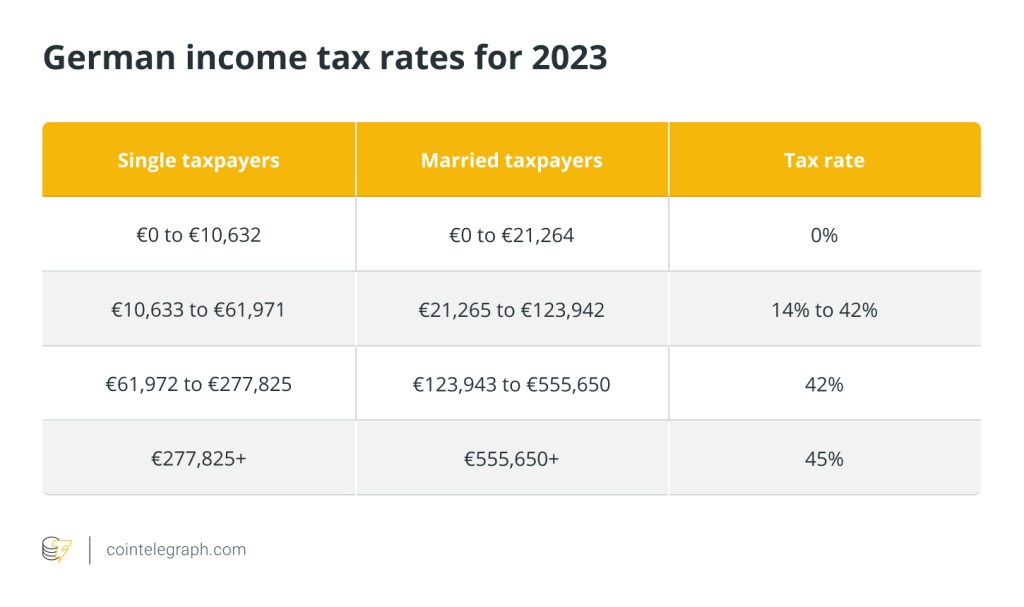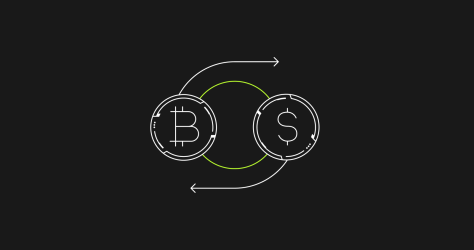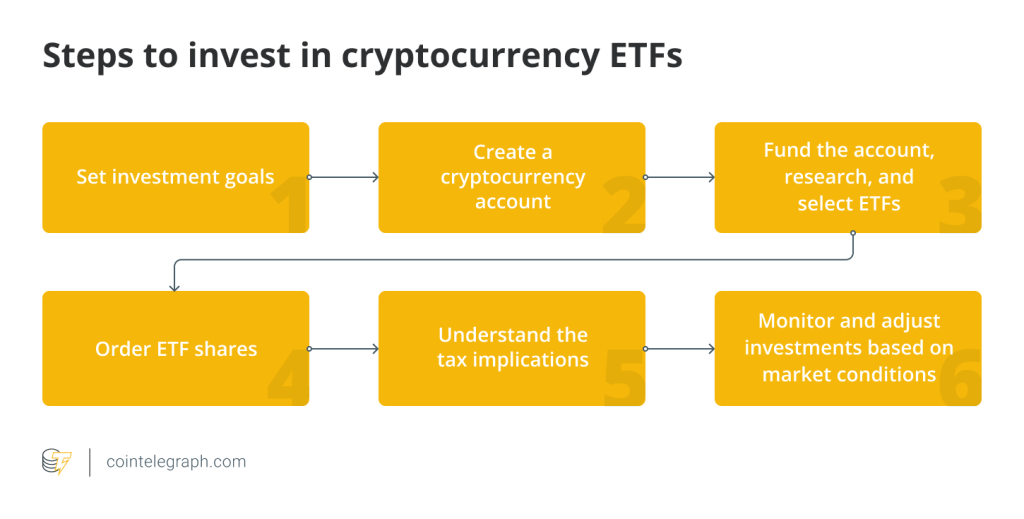Bitcoin ETFs: A beginner's guide to exchange-traded funds


What is a Bitcoin ETF, and how does it work?
Flexible traders who prefer diversifying their portfolios at a lower cost and tax benefits often invest in exchange-traded funds (ETFs). But what is an ETF? Exchange-traded funds are a basket of assets whose shares are traded on a stock market. They blend the characteristics and potential benefits of mutual funds, stocks and bonds.
ETF shares, like individual stocks, are traded throughout the day at varying prices based on the supply and demand in the market. Similarly, Bitcoin (BTC) ETFs track BTC’s value and trade on traditional stock exchanges instead of crypto exchanges, i.e., they are not cryptocurrency exchange-traded funds.
In addition, they allow investors to invest in Bitcoin without the inconvenience of using a cryptocurrency exchange while also giving price leverage. The ProShares Bitcoin Strategy ETF (BITO), which is trading on the NYSE Arca, is an example of a Bitcoin ETF.
Futures are a kind of ETFs that allow investors to protect themselves against turbulent markets by ensuring that they can buy or sell a specific cryptocurrency at a particular price in the future. Investing in cryptocurrency and blockchain companies that provide leverage to the crypto market is another option for obtaining exposure to Bitcoin without actually acquiring it.
An ETF monitors the price of an underlying asset or index. For example, a Bitcoin ETF functions similarly, with the price of one share of the exchange-traded fund fluctuating in lockstep with the price of BTC.
If Bitcoin’s value rises, so does the ETFs, and vice versa, and it would trade on a stock exchange like the New York Stock Exchange. ETFs are now accessible for various assets and industries, including commodities and currencies.
This article explains Bitcoin exchange-traded funds, their advantages, the approval of Bitcoin ETFs by the SEC, spot Bitcoin ETFs, futures ETFs and how to buy them.
Bitcoin futures and spot Bitcoin ETFs
A futures ETF is a fund that represents the value of a cryptocurrency that you can buy or sell based on contract conditions. However, you do not own the underlying crypto asset when purchasing or selling futures. Instead, you possess a contract that promises to buy or sell cryptocurrency at some point in the future.
As a result, futures are shielded from market instability and price swings. On the other hand, futures do not allow you to stake or use coins for voting like you would if you owned the currency outright.
Unlike futures contracts, spots are one-time digital asset purchases that give buyers and sellers direct cryptocurrency ownership. This works similarly to any of the existing crypto exchanges.
The Bitcoin futures ETF structure has faced criticism, as relying on BTC futures rather than spot Bitcoin for pricing may result in underperformance. Another reason traders dislike futures is that they often trade at a higher price than the underlying asset, although they can also trade at a lower price.
Therefore, the key difference between a Bitcoin futures ETF and a spot ETF is that a futures ETF is backed by derivatives (in this case, Bitcoin futures contracts), whereas real BTC backs the spot-based ETF.
More crucially, the price of Bitcoin futures contracts may deviate from the current market price due to investors’ emotions, and it may also track the price incorrectly occasionally. However, in the case of a spot-based ETF, this risk does not exist.
How do Bitcoin futures ETFs work?
Investing in a Bitcoin futures ETF means you agree to purchase or sell BTC at a given price on a specific date, regardless of market conditions. The contract settlement date or expiration date is the agreed-upon date by which both parties must satisfy their obligations.
The party agreeing to buy BTC at the expiry of a Bitcoin futures contract would have to buy it at a discount or premium. The futures market is termed “premium” when the future price trades higher than the spot price.

On the other hand, a “discount” occurs when the spot price is higher than the futures price. Backwardation is the term used in the commodity derivative market, while discount is used in the equity derivative market. The situation is regarded as normal when the futures price converges with the asset’s current price.
The amount that needs to be paid depends upon the spot price and the value of futures contracts the buyer buys. Moreover, investors might hypothetically arbitrage away the spread between the ETF and the underlying asset if it becomes too broad, so the price of an ETF will generally maintain a high correlation with the underlying asset’s price movement.
Downsides of Bitcoin futures ETFs
The most prominent problem with Bitcoin futures ETFs is the lack of accuracy in their price trackers. A negative indicator for investors in Bitcoin futures, called a “contango,” emerges when the price of Bitcoin futures is greater than the spot price, conveying that the ETF is following the price of BTC incorrectly. However, situations where the futures price is lower than the current Bitcoin price lead to backwardation.
When the new contract’s price is higher than the Bitcoin futures contract’s price, the funds from selling contracts that are about to expire will not be enough to buy the same number of contracts that will expire later. As a result, the ETF’s performance will be affected due to this predicament.
How does a spot Bitcoin ETF work?
A spot ETF holds Bitcoin directly and its value is directly linked to the current market price (or spot price) of Bitcoin. When investors buy shares in a spot Bitcoin ETF, they buy a share of the fund’s Bitcoin holdings.
Investors can buy and sell shares of the ETF through traditional stock exchanges, just like they would with any other stock or ETF. This eliminates the need for investors to deal with the complexities of buying, storing and securing Bitcoin directly. Moreover, being part of a regulated market, these ETFs offer investor protection that direct cryptocurrency investments may lack.
Bitcoin futures ETFs are preferred over spot ETFs because the Commodity Futures Trading Commission regulates the futures market and has enormous trading volumes, which can be a prominent place for price discovery.
Spot BTC ETFs are available in Canada. Three significant funds, Purpose Bitcoin, 3iQ CoinShares and CI Galaxy Bitcoin, are all directly invested in spot Bitcoin. Additionally, the 21Shares Bitcoin exchange-traded products, which are 100% exposed to spot BTC, are listed on various German exchanges and the Swiss Exchange with assets under management of about $500 million.
The SEC gave the green light to 11 spot Bitcoin ETFs on Jan. 11, 2024, marking a significant development in cryptocurrency investment. This historic decision comes after numerous unsuccessful efforts by ETF providers to get approval for spot Bitcoin products.
Previously, the SEC had concerns about the essentially unregulated Bitcoin market and its susceptibility to manipulation, which it believed posed risks to ordinary investors. The approved ETFs are as follows:
- Grayscale Bitcoin Trust
- Bitwise Bitcoin ETF
- Hashdex Bitcoin ETF
- BlackRock's iShares Bitcoin Trust
- Valkyrie Bitcoin Fund
- ARK 21Shares Bitcoin ETF
- Invesco Galaxy Bitcoin ETF
- VanEck Bitcoin Trust
- WisdomTree Bitcoin Fund
- Fidelity Wise Origin Bitcoin Fund
- Franklin Bitcoin ETF
This advancement opens new avenues for investors to engage with Bitcoin in a more regulated and potentially safer environment.
Investing in Bitcoin ETFs
Investors seeking exposure to Bitcoin through ETFs in the United States may consider the Bitcoin Strategy ETF listed on the Mercantile Exchange of Chicago, commonly known by its ticker symbol BITO. This fund allows individuals to gain exposure to Bitcoin’s price movements without directly holding the cryptocurrency, offering a more regulated investment avenue.
Prospective investors can acquire BITO through various online brokerages such as Robinhood or Fidelity by opening a brokerage account. Once the account is established, they can decide on the desired number of shares and set a purchasing price. Investors can navigate the acquisition process by utilizing either market orders, which execute at the prevailing market price, or limit orders, specifying the highest acceptable purchase price.
However, whether investing in a Bitcoin ETF is advantageous depends on one’s investment goals. For those with a long-term perspective on Bitcoin, futures-based ETFs may not be the most suitable choice. Potential considerations include the potential deviation from the net asset value, fund fees and roll expenses, which investors should carefully assess before committing to an ETF investment.
In ETFs, “roll expenses” refer to the costs of rolling futures contracts. The difference in prices between the old and new contracts, known as the “roll yield,” can lead to roll expenses, impacting the fund's overall performance.
Pros and cons of Bitcoin ETFs
Investing in a Bitcoin ETF allows you to have exposure to the price of Bitcoin without dealing with a cryptocurrency exchange, having to learn how BTC works or taking on the risks of directly owning Bitcoin. Without the fear of losing your wallet password, the process of investing in Bitcoin is made more accessible with Bitcoin futures or spot ETFs.
Furthermore, as an ETF combines various securities like Google stocks, BTC and more, it allows investors to diversify their portfolios and reduce risk exposure. Since Bitcoin futures ETFs are regulated by the SEC as they trade on traditional exchanges, they are eligible for tax efficiency.
A large amount of Bitcoin ETFs means high management fees. However, the SEC’s concurrent approval of multiple spot Bitcoin ETFs ignited competitive pricing among issuers, benefiting investors with lower fees. Unlike existing crypto funds like Grayscale trusts (2–3% fees) and the largest Bitcoin futures ETF (0.95% fee), spot Bitcoin ETFs, such as Bitwise’s, offer significantly reduced fees, with a proposed rate of only 0.20%. This fee competition is crucial for attracting investment in this burgeoning market.
Also, an ETF has multiple holdings, which means that a rise or decline in BTC’s price may lead to price inaccuracy. In addition, because an ETF is not a cryptocurrency (but rather an investment fund that tracks the price of BTC), a Bitcoin ETF would not be allowed to be traded in exchange for other digital currencies.
Bitcoin eliminates third parties and provides decentralization and security through the Bitcoin blockchain, but these advantages are lost when investing in a government-regulated ETF.
Alternatives to Bitcoin ETFs
Owning Bitcoin gives investors direct exposure to the cryptocurrency market. So, if you don’t want to invest in Bitcoin ETFs, you can directly invest in other digital assets like BTC, Ether (ETH) or Tether (USDT) through cryptocurrency exchanges like Binance, Coinbase and KuCoin.
Alternatively, you can buy shares of public cryptocurrency exchanges like Coinbase. These are called blockchain ETFs, which can provide technology-related exposure without directly investing in the currencies.
Bitcoin ETFs vs. Blockchain ETFs
While Bitcoin exchange-traded funds are relatively new, the number of blockchain ETFs continues to expand. Blockchain technology is not prohibited nor under regulatory examination. On the other hand, digital currencies have been limited or outright banned in several countries.
Bitcoin ETFs track the price of Bitcoin and trade on standard stock exchanges. In contrast, Blockchain ETFs, such as the Bitwise Crypto Industry Innovators ETF, track the stock market prices of corporations investing in blockchain technology.
The road ahead
Bitcoin ETFs can help investors find a middle ground between the rapidly changing cryptocurrency market and traditional investment vehicles. Buying and selling ETFs through one’s favorite brokerage is similar to trading shares, so it’s a straightforward process.
With the SEC’s approval, these funds are well-positioned to bridge the gap between traditional finance and the rapidly growing cryptocurrency industry, providing a more accessible and regulated investment option for a more extensive range of investors. However, the path is not without difficulties. With the volatility and unpredictability of Bitcoin, authorities will need to strike a balance between investor protection and innovation, which will lead to increased regulatory scrutiny.
Additionally, the competition among ETF providers will likely escalate, leading to more diverse and cost-effective products. This evolution could significantly broaden Bitcoin’s appeal, integrating it more deeply into mainstream investment portfolios. Yet, the inherent risks and market dynamics of cryptocurrencies will continue to test the resilience and adaptability of Bitcoin ETFs.






… [Trackback]
[…] Find More on on that Topic: x.superex.com/academys/beginner/2429/ […]
… [Trackback]
[…] Read More on to that Topic: x.superex.com/academys/beginner/2429/ […]
… [Trackback]
[…] There you will find 38982 additional Info on that Topic: x.superex.com/academys/beginner/2429/ […]
… [Trackback]
[…] Read More to that Topic: x.superex.com/academys/beginner/2429/ […]
… [Trackback]
[…] Information to that Topic: x.superex.com/academys/beginner/2429/ […]
… [Trackback]
[…] Here you will find 66165 more Information on that Topic: x.superex.com/academys/beginner/2429/ […]
… [Trackback]
[…] Here you can find 61241 additional Info on that Topic: x.superex.com/academys/beginner/2429/ […]
… [Trackback]
[…] There you can find 44223 more Information on that Topic: x.superex.com/academys/beginner/2429/ […]
… [Trackback]
[…] Info to that Topic: x.superex.com/academys/beginner/2429/ […]
… [Trackback]
[…] Information to that Topic: x.superex.com/academys/beginner/2429/ […]
… [Trackback]
[…] Info to that Topic: x.superex.com/academys/beginner/2429/ […]
… [Trackback]
[…] Find More to that Topic: x.superex.com/academys/beginner/2429/ […]
… [Trackback]
[…] Find More here to that Topic: x.superex.com/academys/beginner/2429/ […]
… [Trackback]
[…] Find More Info here on that Topic: x.superex.com/academys/beginner/2429/ […]